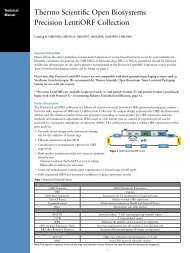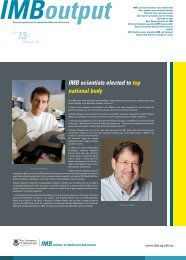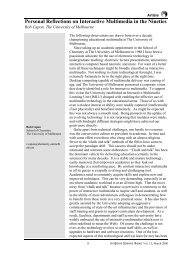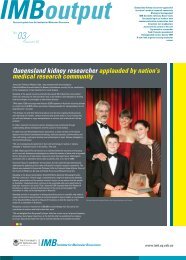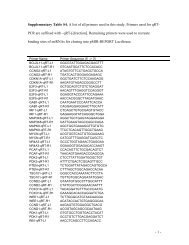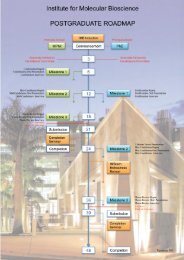2010 Annual Report - Institute for Molecular Bioscience - University ...
2010 Annual Report - Institute for Molecular Bioscience - University ...
2010 Annual Report - Institute for Molecular Bioscience - University ...
Create successful ePaper yourself
Turn your PDF publications into a flip-book with our unique Google optimized e-Paper software.
imb annual report <strong>2010</strong><br />
40<br />
DAGMAR WILHELM<br />
TOWARDS A NEW UNDERSTANDING OF THE<br />
REPRODUCTIVE SYSTEM: FROM NON-CODING<br />
RNAS TO DISEASE<br />
OUR GROUP FOCUSES ON THE<br />
elucidation of regulatory mechanisms<br />
that control gene expression during<br />
embryonic development. One of the<br />
most amazing biological processes is<br />
the development of a fertilised egg into<br />
a complex organism. It involves the<br />
orchestration of cellular processes such as<br />
cell proliferation, migration, differentiation<br />
and apoptosis, which is controlled by a<br />
delicate network of gene regulation and<br />
interaction. Disturbance of this network<br />
by gene mutation or misexpression during<br />
development results in mal<strong>for</strong>mation and<br />
malfunction of organs, diseases such as<br />
cancer, and often lethality. There<strong>for</strong>e, each<br />
of these processes must involve a large<br />
number of regulatory mechanisms.<br />
Until recently our work centred around the<br />
conventional dogma, which states that<br />
gene activity is controlled by transcription<br />
factor binding to proximal promoters and/<br />
or enhancers adjacent to genes. We are<br />
now extending these studies to include<br />
the fact that gene activity is also regulated<br />
post-transcriptionally by non-coding RNAs<br />
(ncRNAs), such as microRNAs. In addition<br />
to investigating the role of microRNAs<br />
during development, we have discovered<br />
a new class of ncRNAs, uaRNAs (3’UTRassociated<br />
non-coding RNAs), that displays<br />
a highly regulated stage- and sex-specific<br />
expression pattern during embryogenesis.<br />
Furthermore, we want to use the<br />
knowledge of small RNA processing and<br />
function, also called RNA interference<br />
(RNAi), as a tool to control pest species in<br />
Australia. The common carp represents an<br />
increasing menace to Australian freshwater<br />
ecosystems. Further unchecked growth<br />
and spread of the carp population poses<br />
a threat to many native fish species. In this<br />
project we are investigating the biology of<br />
RNAi in carp and zebrafish, to investigate<br />
the potential of a “daughterless” approach<br />
by making use of the endogenous RNAi<br />
processing machinery to knock down<br />
aromatase and thereby control carp<br />
numbers.<br />
Our research uses mouse and zebrafish<br />
as model systems and integrates<br />
molecular and developmental biology to<br />
study mechanisms of gene regulation<br />
by transcription factors as well as<br />
ncRNAs during embryonic development,<br />
concentrating on sex determination and<br />
gonad development but extending to<br />
other developmental systems such as<br />
chondrogenesis.<br />
The aims of our research are to address<br />
the intersections of the following questions:<br />
1 What are the regulatory mechanisms<br />
underlying the development of the<br />
ovary<br />
2 What are the roles of ncRNAs, including<br />
long and small RNAs, during the<br />
development of testes and ovaries<br />
3 What are the mechanisms of<br />
processing and function of small RNAs<br />
in fish<br />
RESEARCH PROJECTS<br />
• Characterisation of the role of miR-<br />
202 and miR-140 during embryonic<br />
development<br />
• Analysis of novel microRNAs involved in<br />
gonad development<br />
• Functional characterisation of ncRNAs<br />
during embryonic development<br />
• Studying the cellular and molecular<br />
regulation of foetal ovary development<br />
• Characterisation of RNAi in fish<br />
KEY PUBLICATIONS<br />
Mercer, T.R.*, Wilhelm, D.*, Dinger, M.E.*,<br />
Solda, G.*, Korbie, D.J., Glazov, E.A.,<br />
Truong, V., Schwenke, M., Matthaei, K.I.,<br />
Saint, R., Koopman, P., and Mattick, J.S.<br />
(<strong>2010</strong>). Expression of distinct RNAs from<br />
3’ untranslated regions. Nucleic Acids<br />
Research Epub November 12.<br />
McFarlane, L., and Wilhelm, D. (2009).<br />
Non-coding RNA in mammalian sexual<br />
development. Sexual Development 3:<br />
302-316.<br />
Wilhelm, D., Hiramatsu, R., Mizusaki,<br />
H., Widjaja, L., Combes, A.N., Kanai,<br />
Y., and Koopman, P. (2007). SOX9<br />
regulates prostaglandin D synthase<br />
gene transcription in vivo to ensure<br />
testis development. Journal of Biological<br />
Chemistry 282: 10553-10560.<br />
Wilhelm, D., Palmer, S., and Koopman,<br />
P. (2007). Sex determination and gonadal<br />
development in mammals. Physiological<br />
Reviews 87: 1-28.<br />
Wilhelm, D., Martinson, F., Brad<strong>for</strong>d, S.,<br />
Wilson, M.J., Combes, A., Beverdam, A.,<br />
Bowles, J., Mizusaki, H., and Koopman,<br />
P. (2005). Sertoli cell differentiation is<br />
induced both cell-autonomously and<br />
through prostaglandin signalling to<br />
activate Sox9 during mammalian sex<br />
determination. Developmental Biology<br />
287: 111-124.<br />
Wilhelm, D., and Englert, C. (2002). The<br />
Wilms tumour suppressor WT1 regulates<br />
gonadal development by activation of Sf1.<br />
Genes and Development 16: 1839-1851.<br />
LAB MEMBERS<br />
Research Officer: Dr James Palmer<br />
Research Assistants: Vy Truong, Huijun<br />
Chen, Emmanuelle Frampton<br />
PhD Students: Lindsey McFarlane, Elanor<br />
Wainwright<br />
Occupational Trainee: Nicolas Melin<br />
Honours Student: Joanna Rakoczy




